The Camps
 As detailed
here there are a number
of established camps along the main
trail. Conditions/facilities differ. This page provides
a brief overview of each camp. As detailed
here there are a number
of established camps along the main
trail. Conditions/facilities differ. This page provides
a brief overview of each camp.
Nyabitaba Camp
At 2660m above sea-level (0° 22.40′ N
29° 58.66′ E), Nyabitaba is the Day 1 camp.
Legend has it that this
camp site was a homestead of a local chief who grew
tobacco here (some of which still grows near the main
hut) hence the name of the site (The name roughly translates
"Place of tobacco"). At this camp is a 2-room
aluminium hut, inlaid with wood. There are two pit
latrines, running water (piped down from Lake
Mahoma).
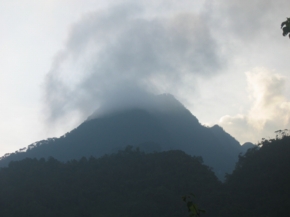 The camp is generally quite warm, given the relatively
low altitude. Afternoons are generally sunny,
providing much-needed warmth.
The camp is generally quite warm, given the relatively
low altitude. Afternoons are generally sunny,
providing much-needed warmth.
Nyabitaba, perched atop a ridge, is situated in
a lightly forested area. One can see the beautiful
Portal Peaks to the north. From this camp, Lake
Mahoma is accessible within a short distance to the
west. As such a two-day trip into the Rwenzoris is
conceivable and still offers a rich experience.
John Matte Camp
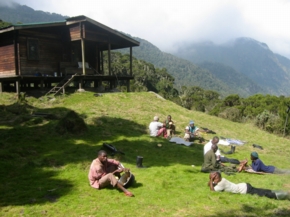 Named after a founding president of the
mountaineering club of Uganda, John Matte (3420m, 0° 22.90′ N
29° 55.69′ E) is situated on a grassy hillside
on the banks of River Bujuku. The camp tends to be
quite wind-swept and therefore cold, although the
occasional afternoon sunshine may offer some
warmth. The ground does however get soggy quite quickly
when it rains. Named after a founding president of the
mountaineering club of Uganda, John Matte (3420m, 0° 22.90′ N
29° 55.69′ E) is situated on a grassy hillside
on the banks of River Bujuku. The camp tends to be
quite wind-swept and therefore cold, although the
occasional afternoon sunshine may offer some
warmth. The ground does however get soggy quite quickly
when it rains.
The camp consists of a 3-room wooden hut. A pit
latrine is available, as well as a make-shift kitchen
and porter's accomodation. On a clear day, the Portal Peaks as well as Margherita
are visible from John Matte.
Bujuku Camp
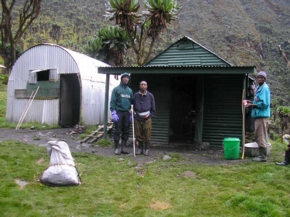 Situated on a
slope at
the northeastern tip of Lake Bujuku, Bujuku Camp(3930m, 0° 22.98′ N
29° 53.19′ E) has perhaps the poorest facilities
at present. Consisting of a single-room tin hut (there
is another for the guide and porters), this camp can be
quite cold. Situated on a
slope at
the northeastern tip of Lake Bujuku, Bujuku Camp(3930m, 0° 22.98′ N
29° 53.19′ E) has perhaps the poorest facilities
at present. Consisting of a single-room tin hut (there
is another for the guide and porters), this camp can be
quite cold.
The camp offers a breath-taking view of Lake Bujuku
and the surrounding peaks. On a clear day, Scott
Elliot Pass, the Stanley Plateau and Mt. Baker can be
seen clearly. This camp also offers opportunities to
spot the elusive duika antelope.
The camp is a staging post for the trip to Elena Hut
(and hence to Margherita) or to Mt. Speke. Trekkers to
Mt. Speke will head out of this camp to attempt the
peak.
Elena Camp
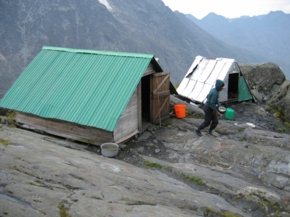 Wedged between
two large flat rocks, Elena Hut (4563m, 0° 22.27′ N
29° 53.86′ E) is the staging post for climbing
Mt. Stanley. At the best of times conditions at this
camp are bleak. Temperatures at this
camp-in-the-clouds hover around the freezing
mark during the day, and plummet will below freezing at
night. Wedged between
two large flat rocks, Elena Hut (4563m, 0° 22.27′ N
29° 53.86′ E) is the staging post for climbing
Mt. Stanley. At the best of times conditions at this
camp are bleak. Temperatures at this
camp-in-the-clouds hover around the freezing
mark during the day, and plummet will below freezing at
night.
On a clear day the camp offers a excellent views of
Mt. Baker, Mt. Speke and Lake Kitandara. It also
offers the first close-up view of the Mt. Stanley
glaciers.
The rocks around Elena Hut can be quite treacherous
when wet. In addition, finding ones way over these
rocks can be tricky, given the dearth of
landmarks. Paths are however conveniently marked using
small heaps of stones.
Kitandara Camp
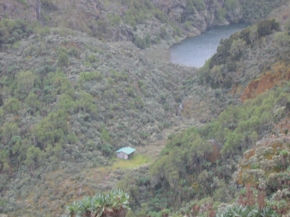 Situated on
the shores of Lower Kitandara Lake, Kitandara Camp
(3979m, 0° 20.70′ N
29° 53.05′ E) easily wins the camps beauty
contest. The one-room tin hut notwithstanding, its
location next to the beautiful Lake Kitandara is simply
breath-taking. On a good day it
offers views of the Savoy Glaciers, and a number of
peaks in the area. Situated on
the shores of Lower Kitandara Lake, Kitandara Camp
(3979m, 0° 20.70′ N
29° 53.05′ E) easily wins the camps beauty
contest. The one-room tin hut notwithstanding, its
location next to the beautiful Lake Kitandara is simply
breath-taking. On a good day it
offers views of the Savoy Glaciers, and a number of
peaks in the area.
Given its relatively warm conditions, the surrounding
forests support a variety of bird species, which can
be heard chirping throughout the day and night.
An alternate route to the summits passes through
Kitandara. Mt. Baker is also best approached via
Kitandara (and a climb to Freshfield Pass).
Guy Yoeman Camp
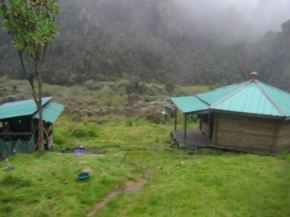 Situated on a
the banks of River Mubuku, Guy Yoeman camp (3505m, 0° 20.61′ N
29° 56.47′ E) is surrounded by coniferous
forests. The camp consists of a single 2-room wooden
hut (and another for the guide and porters), a
make-shift kitchen and a pit latrine. Situated on a
the banks of River Mubuku, Guy Yoeman camp (3505m, 0° 20.61′ N
29° 56.47′ E) is surrounded by coniferous
forests. The camp consists of a single 2-room wooden
hut (and another for the guide and porters), a
make-shift kitchen and a pit latrine.
Near the camp is a spectacular waterfall, perhaps 30
metres high.
The camp offers reasonable warm conditions, with
daytime temperatures in the 10-15°C
region. However the camp tends to be quite wet and
misty during much of the year.
|

